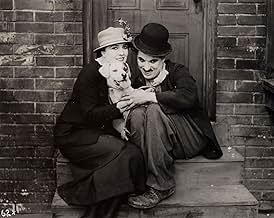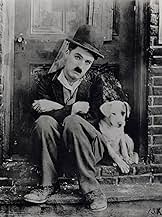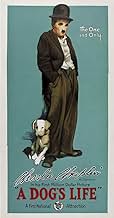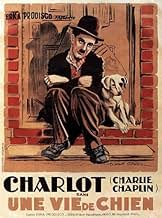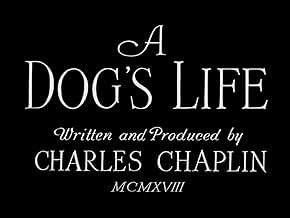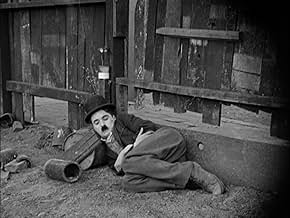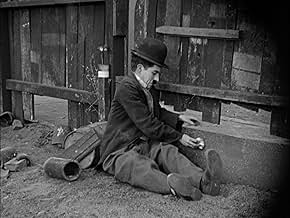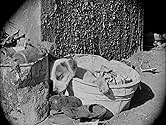The Little Tramp and his dog companion struggle to survive in the inner city.The Little Tramp and his dog companion struggle to survive in the inner city.The Little Tramp and his dog companion struggle to survive in the inner city.
Edna Purviance
- Bar Singer
- (uncredited)
Dave Anderson
- Bartender
- (uncredited)
Bert Appling
- Unemployed Man
- (uncredited)
Albert Austin
- Crook
- (uncredited)
Henry Bergman
- Fat Unemployed Man
- (uncredited)
- …
Alva D. Blake
- Man in Dance Hall
- (uncredited)
Mel Brown
- Employment Agency Clerk
- (uncredited)
- …
Minnie Chaplin
- Dance-Hall Dramatic Lady
- (uncredited)
Syd Chaplin
- Lunchwagon Owner
- (uncredited)
Dorothy Cleveland
- Woman in Dance Hall
- (uncredited)
Slim Cole
- Unemployed Man
- (uncredited)
Margaret Cullington
- Woman in Dance Hall
- (uncredited)
Billy Dill
- Man in Dance Hall
- (uncredited)
Margaret Dracup
- Woman in Dance Hall
- (uncredited)
Jack Duffy
- Man in Dance Hall
- (uncredited)
Robert Dunbar
- Old Man in Dance Hall
- (uncredited)
Ella Eckhardt
- Woman in Dance Hall
- (uncredited)
- Director
- Writer
- All cast & crew
- Production, box office & more at IMDbPro
Featured reviews
This was Charlie Chaplin's first film for First National, and with his pictures there, he could create movies of longer, or varied, length, rather than the two-reelers he was obliged to churn out before. His Mutual shorts were a vast improvement over his previous work, but watching them I'd sometimes get the sense that his ideas required more time to elaborate, to fully realize, or unfold. The hilarity of the gags in "A Dog's Life" result from this newly acquired freedom to expand his films.
I don't think it's one of Chaplin's most important works, or one of his best, but "A Dog's Life" is very funny and left me in high spirits. The crying set piece was hilarious. As well, Chaplin continued to use props and settings to his comedic advantage, such as with the missing boards and the door of his fenced home when he eludes a policeman in the beginning of the film.
Perhaps, the most interesting aspect of this one is the elaborate pantomime that goes on. The creation of the world within a silent film often created problems for lesser filmmakers on what the role of sound is within that world. There is obviously sound in the world of "A Dog's Life", but the tramp continually ignores it and oft prefers to use pantomime to express himself--or others, as in the elaborate scene using his hands. This demonstrated a lot of thought on Chaplin's part, and it's something that could be done only in the silent era. For all the comic genius in America at the time, the fact that the clowns couldn't talk shouldn't be overlooked, for it was full of advantages.
I don't think it's one of Chaplin's most important works, or one of his best, but "A Dog's Life" is very funny and left me in high spirits. The crying set piece was hilarious. As well, Chaplin continued to use props and settings to his comedic advantage, such as with the missing boards and the door of his fenced home when he eludes a policeman in the beginning of the film.
Perhaps, the most interesting aspect of this one is the elaborate pantomime that goes on. The creation of the world within a silent film often created problems for lesser filmmakers on what the role of sound is within that world. There is obviously sound in the world of "A Dog's Life", but the tramp continually ignores it and oft prefers to use pantomime to express himself--or others, as in the elaborate scene using his hands. This demonstrated a lot of thought on Chaplin's part, and it's something that could be done only in the silent era. For all the comic genius in America at the time, the fact that the clowns couldn't talk shouldn't be overlooked, for it was full of advantages.
A Dog's Life has more layers than the usual Chaplin films, taking the character slightly more literally than he usually does. The overall appeal of Chaplin's Little Fellow is that he is such an everyman that he can be thrust into an almost endless multitude of situations, and Chaplin uses his limitless talent to mold it into brilliant, humanitarian farce. In this film, the little tramp is more of a homeless fellow than usual (I think he's usually just poor and struggling), and in the process he be-friends another homeless and struggling tramp.
There are some great scenes in the film, although even at only 40 minutes it is a bit too long for the material to support. One scene in particular, where Charlie knocks a bully unconscious, is going to be the most memorable one in the movie, along with a scene where he outsmarts some police officers. There is a charming romance that is neither cloying nor overly involving, just the right amount for a short, light-hearted comedy. This probably would have worked even better as a two reel film, but as it is it stands as one of Chaplin's better three reelers.
There are some great scenes in the film, although even at only 40 minutes it is a bit too long for the material to support. One scene in particular, where Charlie knocks a bully unconscious, is going to be the most memorable one in the movie, along with a scene where he outsmarts some police officers. There is a charming romance that is neither cloying nor overly involving, just the right amount for a short, light-hearted comedy. This probably would have worked even better as a two reel film, but as it is it stands as one of Chaplin's better three reelers.
Let's face it : Chaplin's short films, before 1917, are not so good and funny anymore. After 1917, and waiting to make longer films, there are three films I'm really found of : The Imigrant, Shoulder Arms and A Dog's Life. I love A Dog's Life because Chaplin was never trampier than in this film. He's poor, miserable, probably dirty! He really looks like a real tramp! So is his dog! The dog is simply wonderful in this film!
Funny gags all the way. I'm mad about a scene in the café, when Edna Purviance sings a very sad song and makes everybody's crying. In my version, on video, they put some strange music while she sings, like a saw sound. It's a very funny sounds effect for the image of miss Purviance! The story is very sample and warm. This is Chaplin's shorts at his best!
Funny gags all the way. I'm mad about a scene in the café, when Edna Purviance sings a very sad song and makes everybody's crying. In my version, on video, they put some strange music while she sings, like a saw sound. It's a very funny sounds effect for the image of miss Purviance! The story is very sample and warm. This is Chaplin's shorts at his best!
Just like his little tramp alter ego, Charlie Chaplin liked to think big, and had always aimed to extend the scale and scope of his pictures, never content to be a two-reel sideshow. At 35 minutes, A Dog's Life could hardly be described as his first full-length feature, but it arguably represents his break away from shorts.
Just the opening shot of A Dog's Life shows how Chaplin is starting to inject some grand sweep into his storytelling. The camera begins amid city rooftops, tilting down to reveal Charlie sleeping amid the rubbish behind a ramshackle fence. The way this purpose-built set is shot demonstrates how Chaplin was as much a "proper" director as a comic. He several times has a shabby sign advertising "rooms" visible in the background – a subtle reminder that the tramp is too poor even for the cheapest accommodation.
It's a nice touch how Charlie's canine friend is introduced in a handful of cutaways during this opening scene – treating him as a real character rather than just a plot device. But this is not to the detriment to his human companions, and indeed leading lady Edna Purviance gets a more substantial part than she did in many of the shorts. She makes a really great character here, giving an impression of a naïve but feisty youngster, certainly more than just a token female. It's this kind of characterisation that gives A Dog's Life the kind of comprehensive structure of a feature film, as opposed to a comedy short in which people just turn up on screen for a bit of funny business.
On a quick side-note, this is the earliest Chaplin picture which features a score written by him (although since he wrote the music in retrospect some decades later it's not the first he wrote). It's another testament to the breadth of his genius, showing both considerable musical ability as well as his own irreverent personality. Numbers like the dance hall rag are of course very "silent comedy", but pieces like the opening theme have a truly deep and epic feel to them. Even here though, the Chaplin cheekiness shines through, with different parts of the orchestra playing off each other in a kind of question-and-answer routine.
Chaplin would repeat this "little companion" routine, swapping dog for tot in his first genuine full-length feature The Kid. A Dog's Life remains a worthy predecessor, part of the comedian's ever upward trajectory at this point in his career. It would take more battling with studio heads for Chaplin to get his ideas fully realised, but it was pictures like this that began to get silent comedy taken seriously.
Just the opening shot of A Dog's Life shows how Chaplin is starting to inject some grand sweep into his storytelling. The camera begins amid city rooftops, tilting down to reveal Charlie sleeping amid the rubbish behind a ramshackle fence. The way this purpose-built set is shot demonstrates how Chaplin was as much a "proper" director as a comic. He several times has a shabby sign advertising "rooms" visible in the background – a subtle reminder that the tramp is too poor even for the cheapest accommodation.
It's a nice touch how Charlie's canine friend is introduced in a handful of cutaways during this opening scene – treating him as a real character rather than just a plot device. But this is not to the detriment to his human companions, and indeed leading lady Edna Purviance gets a more substantial part than she did in many of the shorts. She makes a really great character here, giving an impression of a naïve but feisty youngster, certainly more than just a token female. It's this kind of characterisation that gives A Dog's Life the kind of comprehensive structure of a feature film, as opposed to a comedy short in which people just turn up on screen for a bit of funny business.
On a quick side-note, this is the earliest Chaplin picture which features a score written by him (although since he wrote the music in retrospect some decades later it's not the first he wrote). It's another testament to the breadth of his genius, showing both considerable musical ability as well as his own irreverent personality. Numbers like the dance hall rag are of course very "silent comedy", but pieces like the opening theme have a truly deep and epic feel to them. Even here though, the Chaplin cheekiness shines through, with different parts of the orchestra playing off each other in a kind of question-and-answer routine.
Chaplin would repeat this "little companion" routine, swapping dog for tot in his first genuine full-length feature The Kid. A Dog's Life remains a worthy predecessor, part of the comedian's ever upward trajectory at this point in his career. It would take more battling with studio heads for Chaplin to get his ideas fully realised, but it was pictures like this that began to get silent comedy taken seriously.
This film was one of three that were later combined by Chapin into a compilation that was released to theaters in the late 1950s under the title "The Chaplin Review".
Of the three films combined for The Chapline Review, this is probably the most familiar in style and, to me, the least interesting. While it is STILL a very good film, it just didn't seem all that new or different. We have the Little Tramp down on his luck and looking to feed himself when he stumbles upon a poor lonely dog being picked on by the other dogs. So, he adopts it and they both set out on some adventures. I know this may sound strange, but to me this film felt a lot like an earlier incarnation of THE KID--though of course in this case it's a cute mutt and not Jackie Coogan. A very good and entertaining short with no serious flaws.
Of the three films combined for The Chapline Review, this is probably the most familiar in style and, to me, the least interesting. While it is STILL a very good film, it just didn't seem all that new or different. We have the Little Tramp down on his luck and looking to feed himself when he stumbles upon a poor lonely dog being picked on by the other dogs. So, he adopts it and they both set out on some adventures. I know this may sound strange, but to me this film felt a lot like an earlier incarnation of THE KID--though of course in this case it's a cute mutt and not Jackie Coogan. A very good and entertaining short with no serious flaws.
Did you know
- TriviaThis was Charles Chaplin's first film for First National Pictures under a $1M contract where Chaplin had full creative control over his films for the first time.
- GoofsDuring the fight at the lunch cart, one of the props holding up the awning gets knocked away. In subsequent shots, the prop is back in place.
- Quotes
Title Card: When dreams come true.
- ConnectionsEdited into The Chaplin Revue (1959)
Details
- Release date
- Country of origin
- Official sites
- Languages
- Also known as
- A Dog's Life
- Filming locations
- Production company
- See more company credits at IMDbPro
- Runtime33 minutes
- Color
- Sound mix
- Aspect ratio
- 1.33 : 1
Contribute to this page
Suggest an edit or add missing content


